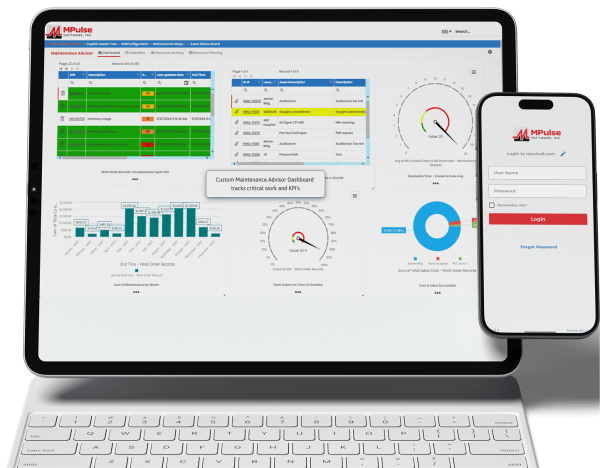Switching to CMMS software enables organizations to automate maintenance tasks, improve asset tracking, and enhance overall operational efficiency.
Implementing CMMS software in educational institutions can strengthen maintenance practices, resulting in better equipment reliability and minimized downtime. The key lies in embracing data-driven management, where your team makes informed decisions based on accurate data rather than assumptions or perceptions.
With the advancement of CMMS technology, facility managers now have access to more comprehensive and relevant data about their assets. This data unveils valuable insights, providing opportunities for your organization to optimize operations and streamline workflows.
Many education facilities cite one or more of the following seven reasons as to why they’re switching to CMMS software.
Table of Contents
Reasons Why Education Facilities Are Switching to CMMS Software
Reason #1: Streamlined Maintenance Management
Preventive maintenance (PM) is the first line of defense for reducing the risk of equipment or asset failure. CMMS simplifies the process by generating a schedule of PM tasks based on manufacturer guidelines and then automating work orders for these tasks and inspections. As a result, your team can identify and address issues before they become major problems. You choose maintenance intervals based on time, operating hours, or the condition of specific parts.
By scheduling maintenance just before system inefficiencies or failures are expected to occur, CMMS ensures that equipment is appropriately calibrated and lubricated as needed. Well-maintained assets operate more efficiently, consume less energy, and experience fewer failures, ultimately prolonging their useful life. This proactive approach helps education facilities avoid serious problems resulting from neglect. It also delays the need for more expensive maintenance.
Reason #2: Cost Savings
Successful CMMS implementations typically return 3 to 5 times the initial investment in less than three years. The average gross savings on maintenance expenditures range from 10% to 40%, according to MPulse’s internal research. Plus, like most successful investments, CMMS benefits compound over time. As your data becomes more comprehensive, your organization becomes more efficient and the return on investment climbs.
CMMS helps you capture key data and turn it into reliable information to help make cost-effective choices about asset management. This data helps organizations make effective replace-or-repair decisions. Maintenance software can track not only the age of the equipment, but also miles, hours, life-to-date repair dollars, and many other metrics—helping you decide when it becomes cheaper to replace an asset instead of repairing it.
Reason #3: Asset Lifecycle Management
Schools, colleges, and universities have numerous assets that require regular maintenance and replacement. As assets age, they can easily cost more than they’re worth. CMMS software helps track the entire lifecycle of assets, from acquisition to disposal. PM scheduling and work order management in CMMS also helps ensure your assets are properly maintained to deliver the best possible ROI.
You can capture a wealth of data with every work order or scheduled PM task in your CMMS. This data helps you make informed decisions about the condition of every asset. With accurate asset data and maintenance history, your education facility can make informed decisions about when to repair or replace assets, resulting in better resource allocation and budget planning.
Reason #4: Compliance and Safety
The maintenance department holds a lot of responsibility for the safety of your institution’s faculty, staff, students, and visitors. Compliance in the maintenance department requires documentation, specifically for creating procedures and recording maintenance activities. Luckily, CMMS software excels at compliance documentation. Your CMMS data provides both the big picture and the little details, so your maintenance tasks are both visible and verifiable.
CMMS software provides the right tools to document important compliance information. You can quickly produce status reports and documents giving details or summaries of your team’s maintenance work. With solid data and easy-to-read reports, your organization can support compliance requirements based on hard evidence, which will improve your ability to respond to inspections and audits. You’ll also be able to identify issues long before your organization receives a visit.
Reason #5: Improved Reporting and Analytics
CMMS software generates comprehensive maintenance reports, offering insights into key performance indicators, maintenance costs, work order history, and asset performance. These reports help educational institutions analyze trends, identify areas for improvement, and make data-driven decisions to optimize maintenance strategies. By having access to concrete data, you not only gain better control over your facility operations, but you also can evaluate and utilize various key performance indicators.
CMMS software uses comprehensive tracking tools for financial and business metrics. Some vendors even offer budgeting tools specifically designed for cost centers. You can swiftly generate status reports and documents that provide detailed or summarized information about your maintenance team’s work. With accurate metrics at your disposal, you can assess the cost-effectiveness of new equipment installations or facility improvements.
Reason #6: Enhanced Communication and Collaboration
The maintenance department is in the unique position of interacting with most, if not all, other departments. CMMS software fosters better communication and collaboration among your team, faculty, staff, and administrators. It starts with the submission of maintenance requests through an online portal, allowing users to report issues directly. The software also provides real-time updates on work order status, facilitating transparency and improving communication between different stakeholders.
Additionally, historical data captured with each work order in CMMS helps technicians share information with each other. Everything your team needs is at their fingertips—repair history, asset details, vendor information, maintenance manuals, websites, and other important data. Most importantly, maintenance teams can streamline their workflow process in a single application. Mobile CMMS takes communication to the next level, with easy access to this information on a mobile device.
Reason #7: Stakeholder Satisfaction
Equipment breakdowns and downtime can affect students’ learning environment, teachers’ ability to deliver lessons, and the overall perception of the educational institution. Proactive maintenance strategies help maintain a reliable and well-functioning facility, leading to increased stakeholder satisfaction. CMMS software automates and streamlines maintenance workflows, ensuring that tasks are efficiently managed and executed. Stakeholders benefit from reduced wait times, faster resolution of issues, and improved service delivery.
Direct, accessible communication is essential to customer satisfaction. Switching to CMMS software provides a centralized platform for stakeholders to communicate and collaborate effectively. It enables stakeholders to submit maintenance requests, track progress, and receive updates in real-time. Improved communication also leads to quicker response times, better coordination, and increased satisfaction among stakeholders.
The Benefits of Switching to CMMS Software
Switching to CMMS software contributes to a more efficient and effective educational environment for students, staff, and faculty. So, what are you waiting for?
Have questions? We have answers. Contact us.






